Laptop Mag Verdict
The Asus ROG Strix GL503 is a sleek entry-level gaming PC with a gorgeous display, but you'll have to put up with slow storage and a janky touchpad.
Pros
- +
Sleek new lid design
- +
Excellent display
- +
Customizable RGB keyboard
Cons
- -
Frustratingly slow SSHD
- -
Crunchy touchpad
- -
Audio distortion at high volumes
Why you can trust Laptop Mag
Budget gaming laptops need a makeover, and Asus might be the company to give them one. The $1,099 Asus ROG Strix GL503 is one of the best-looking entry-level gaming notebooks you can get. The company smartly borrowed the looks from its more premium laptops and applied them here. It also has a bright, vivid display and an RGB keyboard with customizable backlighting, which is often reserved for more expensive machines. But while its Nvidia GTX 1050 GPU and Core i7 CPU are powerful, the hybrid SSHD is slow, and data transfers and reboots take a long time. (Luckily, it's easy to upgrade.) If you're looking for an entry-level gaming laptop in a premium rig's clothes, the Strix will help you look the part.
Design
From afar, the Strix looks way more premium than you'd think. That's because Asus took the lid from one of its flagship notebooks, the ROG Zephyrus, and copied it here. The black aluminum lid features a striking diagonal stripe and the ROG logo in a bronze color. Asus really needs to replace the ROG icon with something (anything!) more elegant, but even so, the overall design is pretty nice.
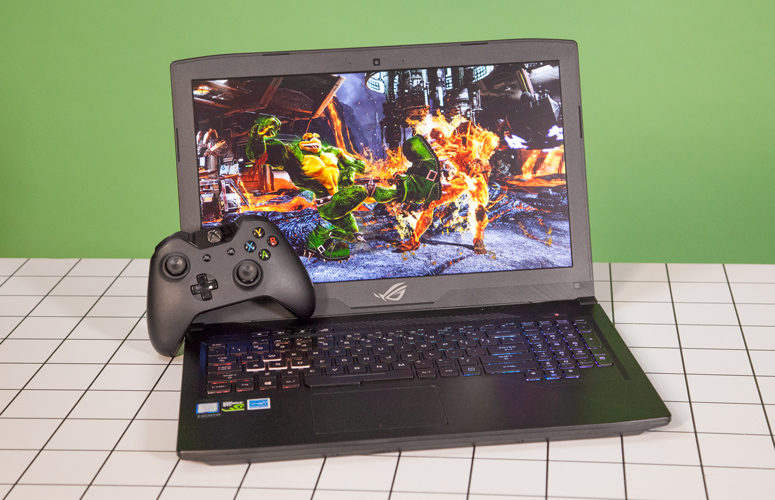
When you open the lid, you'll find the 15.6-inch, 1080p display surrounded by a thick bezel (with another ROG logo -- at least Asus is consistent), a soft-touch deck and an island-style, sRGB backlit keyboard. The parts of the deck that aren't coated in soft-touch material are just plastic.
At 5.6 pounds and 15.1 x 10.3 x 0.9 inches, the Strix GL503 is about the same size as its closest competition. Both the Dell Inspiron 15 5000 Gaming (5.4 pounds, 1 inch thick) and the Acer Aspire VX 15 (5.4 pounds, 1.1 inches thick) are slightly lighter and thicker, while the Lenovo Legion Y520 (5.6 pounds, 1 inch thick) is about the same size.
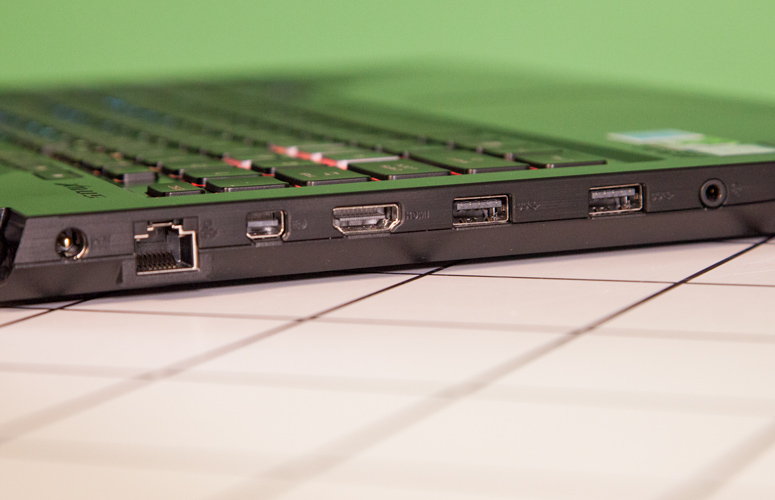
Have a mouse? A hard drive? An external webcam? A monitor? The Strix has ports for all of those and more. On the left side of the chassis are an Ethernet jack, Mini DisplayPort, HDMI output, a pair of USB 3.0 ports and a headphone jack. The right side is home to an SD card slot, a USB 3.0 port, USB 2.0 port and a Kensington lock slot.
If you want to upgrade, it's easy to do so, as the RAM and SSHD are hidden behind just a single screw on the bottom of the unit. (And you might want to replace that SSHD. See the performance section, below.)
Display
The 15.6-inch, 1080p display on the Strix is both bright and very colorful. I watched the trailer for "Tomb Raider" and was impressed by the lush, green foliage in a jungle, and I could make out every water droplet in a rainy scene on a boat. During a session of Battlefield 1, fighting off the Ottoman Empire with Lawrence of Arabia, I could see individual sand particles in a desert storm, and the orange clay on the ground popped against the bright-blue sky.
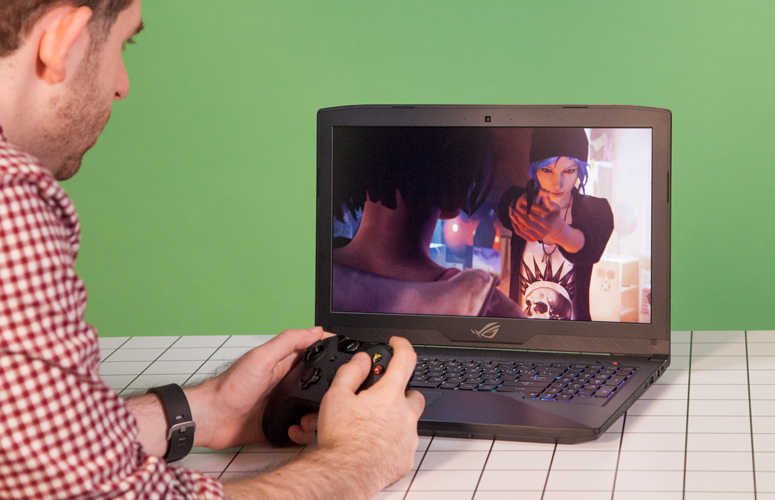
Asus' panel covers an excellent 113 percent of the sRGB color gamut. That's more vivid than the mainstream notebook average (101 percent) and all of the competition: the Aspire (65 percent), Legion (68 percent) and Inspiron (69 percent).
And those colors will be nice and bright. The screen measured 297 nits on our light meter, outshining the category average (257 nits), the Aspire (247 nits), the Legion (220 nits) and the Inspiron (219 nits).
Keyboard and Touchpad
The Strix's keyboard is merely adequate. While it offers a deep 1.9 millimeters of key travel and requires 68 grams of force to press, it feels soft and squishy and doesn't pop up with the force I would like. Still, I typed at 108 words per minute on the 10fastfingers.com typing test (just above my usual 107 wpm) and maintained my standard 2-percent error rate.
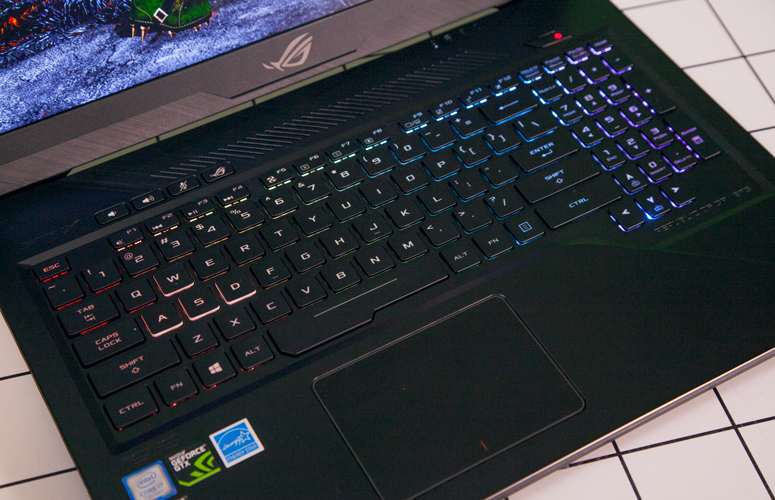
The keyboard does have a few touches I appreciate. For instance, it's RGB backlit, with per-key customization in the ROG Aura Core. (Most low-end laptops do only red backlighting.) There are dedicated keys for adjusting volume, muting a headset and accessing the Gaming Center (but no macro keys), and the W key has a small dot to find the familiar WASD keys without looking, similar to the raised lines on the F and J keys for touch typists.
You're probably going to use a gaming mouse with the Strix, which is good, because the 4.1 x 2.8-inch touchpad is unpleasant to use. Sure, it's smooth and recognizes Windows gestures, but clicking on it is one of the worst feelings I've had using a device in a long time. Left-clicking caused a crunching sound that made me worry something was broken. This would often disappear after one click and then reappear later.
Audio
The Strix has distinct, balanced audio -- at least at medium volumes. When I listened to Train's "Drops of Jupiter," the piano, drums and vocals were all clear, and it filled our lab with sound. At its highest volumes, though, the speakers produced a small but noticeable echo. You can make adjustments in Sonic Studio III, but I found that the preset options were solid.
The same issues popped up in gaming. When I played Battlefield 1, the narrator's voice echoed with the volume turned up, but gunshots rang out loud and clear, making me recoil in my seat.
Gaming and Graphics
The Strix's GTX 1050 GPU isn't the most powerful graphics card on the market, but you'll be able to run most games at more modest settings. When I played Battlefield 1, which is particularly well optimized for the GTX 1050, it ran between 42 and 53 fps on ultra settings at 1080p.
On our budget gaming test, the Strix ran Rise of the Tomb Raider at 1080p on high presets with SMAA anti-aliasing at 44 fps, beating the Inspiron and the Aspire (43 fps each) by a single frame and surpassing the mainstream average of 41 fps.
Performance
With a 2.8-GHz Intel Core i7-7700HQ CPU, 16GB of RAM and a 1TB SSHD hybrid drive, the Strix will plow through everyday work. I had 30 tabs open in Google Chrome, including one streaming a 1080p episode of "Last Week Tonight" with nary a hiccup. My biggest issue was booting up the computer; as you'll see below, that SSHD is quite slow.
On Geekbench 4, the Strix earned a score of 13,754, surpassing the mainstream average (10,291), Legion (12,971, Core i7-7700HQ), Inspiron (10,279, Core i5-7300HQ) and Aspire (10,145, Core i7-7700HQ) with ease.
But it took the Strix 2 minutes and 38 seconds to copy 4.97GB of files, for a rate of 32.2 MBps. That's way slower than the average (239.9 MBps), and the competition was even swifter. The Aspire reached 103 MBps, the Inspiron measured 115.7 MBps and the Legion was the fastest, at a blazing 363.5 MBps.
On the OpenOffice spreadsheet benchmark, which pairs 20,000 names and addresses, the Strix took 3 minutes and 20 seconds. The average is 4:24, and the Strix completed the task faster than the Inspiron (3:44) and the Aspire (3:49). But the Legion Y520 was again the fastest, coming in 1 second ahead, at 3:19.
Battery Life
The Strix may be small enough to fit in a bag, but you'll want to bring the charger, too. It lasted just 3 hours and 32 minutes on the Laptop Mag Battery Test, which browses the web continuously over Wi-Fi. The average is 6:13, though that includes laptops without gaming-focused GPUs.
MORE: Laptops with the Longest Battery Life
The Inspiron was the worst, at 1:43; the Legion lasted just a few minutes longer than the Strix (3:39), and the Aspire lasted almost twice as long (7:08).
Heat
Under normal conditions, the Strix can beat the heat. After we streamed HD video from YouTube for 15 minutes, the laptop measured 87 degrees Fahrenheit on the bottom, 86 degrees between the G and H keys on the keyboard, and 79 degrees on the touchpad. All of those temps are well below our 95-degree comfort threshold.
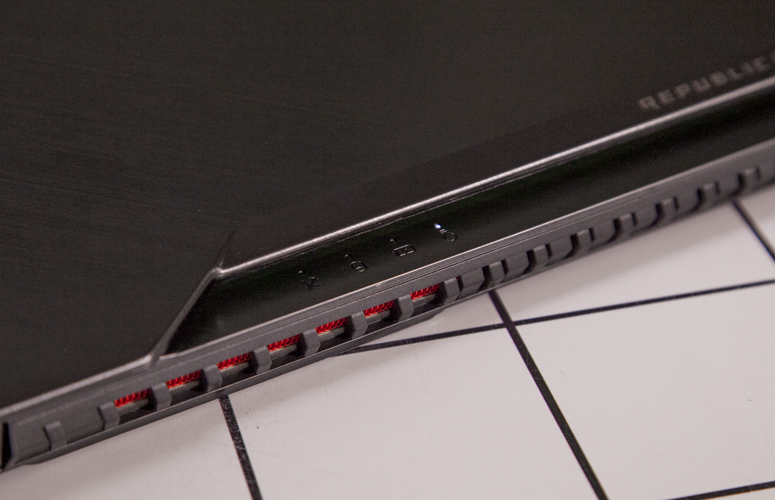
When I played Battlefield 1, the bottom of the laptop climbed to 112 degrees and the center of the keyboard measured 104 degrees, but the touchpad didn't change.
Webcam
In my testing, I found that the 720p webcam on the Strix has a warm tint. While it was sharp enough for me to make out individual hairs on my head, the white spots on my shirt looked yellow, and the red seemed too strong.
Software and Warranty
Asus stuck strictly to gaming software on the Strix. The ROG Gaming Center is the hub, which shows you system specs, GPU and CPU memory and temperature, and fan speeds. It also links you to the other programs, like Sonic Studio, which displays audio options, and Sonic Radar, which shows which direction sound is coming from on-screen.
Otherwise, it's Windows bloat as usual, including Drawboard PDF, Keeper, Plex, Candy Crush Soda Saga, March of Empires: War of Lords, and Skype.
Asus sells the ROG Strix GL503 with a one-year warranty. See how the company performed in our Tech Support Showdown and Best and Worst Gaming Laptop Brands ranking.
Bottom Line
If the screen and design are your highest priorities, the Asus ROG Strix GL503 is the way to go. Its display is brighter and more vibrant than others in the category, and Asus borrowed its premium design and applied it to a low-end gaming notebook.
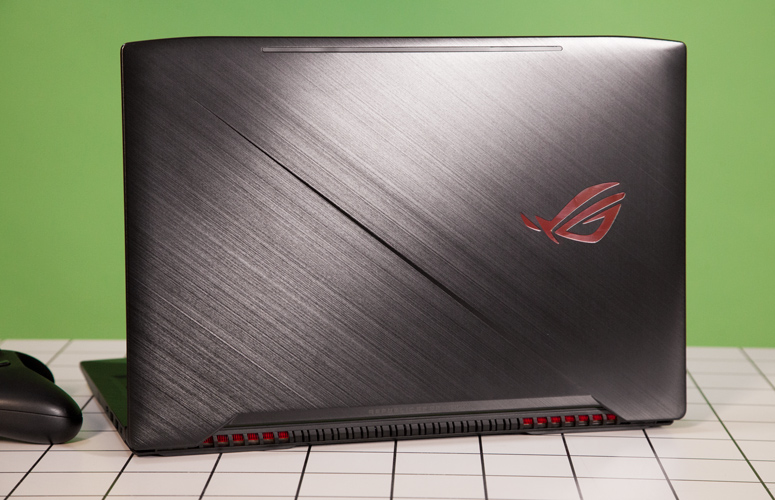
But you can get similar specs for a lower cost. If price is the biggest factor for you, try the Acer Aspire VX 15, which starts at $799.99, or $1,049.99 configured similarly to the Strix. Otherwise, for just a bit more than the Strix, you can get the Lenovo Legion Y520 and upgrade to a GeForce GTX 1050 Ti GPU.
But if looks are important to you and you want the best screen in the price range, sticking to the Strix's GTX 1050 GPU isn't a bad choice. Just use a mouse instead of that unpleasant touchpad, and think about upgrading the storage drive.
Asus ROG Strix GL503 Specs
| Bluetooth | Bluetooth 4.1 |
| Brand | ASUS |
| CPU | 2.8-GHz Intel Core i7-7700HQ CPU |
| Card Slots | SD memory reader |
| Company Website | asus.com |
| Display Size | 15.6 |
| Graphics Card | Nvidia GTX 1050 4GB GDDR5 |
| Hard Drive Size | 1 TB |
| Hard Drive Speed | 5,400rpm |
| Hard Drive Type | Serial ATA Hybrid |
| Highest Available Resolution | 1920 x 1080 |
| Native Resolution | 1920x1080 |
| Operating System | Windows 10 Home |
| Ports (excluding USB) | Headphone/Mic, Kensington Lock, Mini DisplayPort, USB Type-C, USB 2.0, USB 3.0, Ethernet, HDMI-out |
| RAM | 16GB |
| Size | 15.1 x 10.3 x 0.9 inches |
| Touchpad Size | 4.0 x 2.8 inches |
| USB Ports | 5 |
| Video Memory | 4GB |
| Warranty/Support | 1 year warranty |
| Weight | 5.6 pounds |
| Wi-Fi | 802.11ac |
| Wi-Fi Model | 802.11ac |
